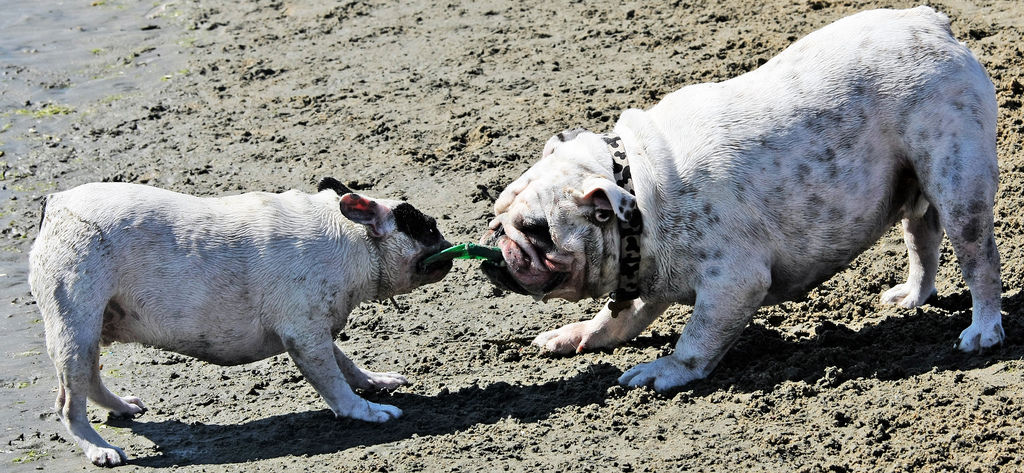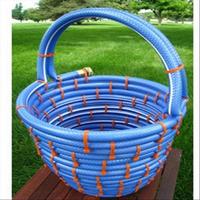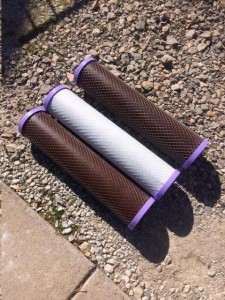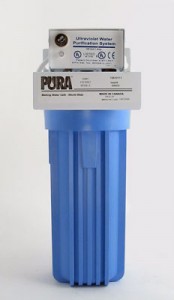Pure Water Occasional, June 10, 2017 |
In this beginning-of-summer Occasional you'll hear about National Garden Hose Day and learn why you shouldn't pee in the lake or take city water for granted. Then, there is rubbish in the ocean off of Australia, lead in Fresno water, zebra mussels in Oklahoma, ambergris in Oman, and an aggressive sea lion in Canada. Meet Spot and Little Arnold, learn about cryptosporidium and well chlorination, and hear about a new coal powered reverse osmosis unit. And, as always, there is much, much more.
Thanks for reading!
|
National Garden Hose Day
by Hardly Waite
|
Hard to believe, Garden Hose Day is again upon us
Moving National Garden Hose Day from August to June makes the holiday’s promoters look like geniuses. Last year’s event, on its new June 21 date, exceeded expectations in terms of crowd sizes, enthusiasm and product sales.
Although Minneapolis has become the unofficial capitol of Garden Hose Day activities, communities large and small around the US are holding Garden Hose celebrations this year. The Garden Hose Tug, an enhanced variation of the good old fashioned Tug O’ War game, remains the main event in most Garden Hose Day celebrations, although garden hose crafts contests, in which contestants show objects they’ve created from garden hoses, are expected to run a close second in popularity at this year’s events.
Last year Cleveland added a canine division to the Garden Hose Tug. In the final round, the event winner, Little Arnold, on the left, bested Spot, his weightier opponent, in less than four minutes.
The common garden hose is one 0f life’s treasures that we take for granted. When you think of it for what it is–a very inexpensive portable pipe that can bend around corners, roll up for storage, and carry high volumes of water quickly over great distances–it deserves our admiration as one of civilization’s simple but awe-inspiring achievements. For simplicity, for efficiency, and for utility, the garden hose is right up there with the canoe, the bicycle, and the clothes line in the list of man’s greatest creations. For gardening, car washing, filling pools–for more of our routine activities that we can recount–the humble garden hose saves time, money, and labor. But for many of us, the garden hose is of greatest importance because it evokes happy memories of childhood and summer days.
We urge you to go to a garden hose event in your neighborhood this year.
An attractive garden hose basket that is a popular item in Amazon garden hose stores. In addition to the almost limitless array of decorative hoses, there are special nozzles, colorful hose bibs, manual and electrically-powered hose dispenser/retractors, hose splitters, hose repair kits, hose unions, hose protectors, and more. Related items include lawn equipment, car wash paraphernalia, clothing, books about gardening, patio cooking, landscaping and washing cars, patio furniture, lawn sprinklers, gardening tools–the list is endless. Yes, even X-rated products that include sex toys and clothing with suggestive phallic mottoes and pictures were on the market this year.
|
How Does Caffeine Get Into Our Water |
It turns out that our bodies don’t absorb all the caffeine we consume. Some gets expelled in our urine and ends up entering sewage systems or the environment, posing a threat to wildlife and perhaps to our health.
Sewage treatment plants usually do a good job removing caffeine, and the treated wastewater they release back into the enviornment is generally free of it.
But in a number of recent studies, caffeine has been detected in water sampled from remote streams – far from urban areas and sewer systems. This suggests our appetite for caffeine has crossed some unseen threshold, and is beginning to impact the environment.

All caffeine comes into the environment through humans.
Literally, through us. There are no natural sources of caffeine in North America. So any caffeine found in water samples surely came from humans, whether in beverages, food or pharmaceuticals. That’s one result of a study recently conducted by the San Diego Regional Water Quality Control Board.
“When we started getting results, we realized it’s way more prevalent than just from leaky sewer lines and septic systems,” said Carey Nagoda, a water resource control engineer for the water board. “So that was kind of a puzzle.”
Nagoda analyzed nearly 100 water samples over a seven-year period from throughout San Diego County and part of Orange County. They came from a range of sites encompassing raw sewage and treated wastewater in urban areas, as well as streams in remote open-space areas where there is no human development.
For example, Cedar Creek Falls, a popular hiking destination in Cleveland National Forest, is one area where the San Diego Regional Water Quality Control Board has detected caffeine in the water.
The results of the study showed that samples from urban areas tested positive for caffeine, which was not surprising. Samples from untreated (raw) sewage contained between 0.052 and 8.5 micrograms per liter, while those taken near active septic systems ranged from 0.029 to 1.19 micrograms per liter.
What was surprising was that more than one-third of the samples from open-space areas tested positive for caffeine. The samples from these areas ranged from 0.032 to 0.662 micrograms per liter, or similar to those samples taken near septic systems.
The areas known for high recreational use – like fishing, horseback riding, hiking, camping – were the ones that had high caffeine levels, suggesting that visitors in these areas may not be practicing good habits, whether by urinating too close to streams or leaving waste behind.
The results also suggest that other contaminants found in human waste, such as pharmaceuticals and pathogens, could be polluting these areas.
Numerous studies have shown that caffeine is toxic to a variety of wildlife at high concentrations. The effects are less clear in cases of continual exposure at low levels because little research has been done in this area. So far, clear toxic thresholds have yet to be firmly established.
To cite an example, one study showed that mussels exposed to
caffeine may face a risk of genetic mutation. Other research at UC Irvine found that caffeine in seawater may contribute to coral bleaching.
Studying caffeine contamination is complicated. Researchers learned, for example, that caffeine is easily aerosolized. So, a Starbucks in the neighborhood can skew test results. Currently, there are no water-quality standards established for caffeine in wastewater effluent.
At present, the best defense against caffeine in our water depends on the habits of individuals. It matters where you urinate. One expert advises: “… don’t dump leftover caffeine beverages or containers where they could enter streams or storm drains. And when enjoying the outdoors, exercise proper bathroom practices. That means using a designated restroom or outhouse whenever available. If that’s not possible, choose a proper site at least 200 feet from any waterway. Residents should do their part to help reduce caffeine release to the environment . . . .The cumulative effect on ecosystem health is not known at this time.”
Removing caffeine from water in the home? While caffeine at levels that might be in tap water is not considered a contaminant of concern for human health, filtration through standard activated carbon filters should reduce it significantly. There is currently no plan to regulate levels of caffeine in tap water.
|
City Water: Take Nothing for Granted
by Gene Franks
|
|
The two discolored carbon block cartridges in the photo turned blood red with rust stains and clogged after only two months of service at a home served by a small municipal water supply in Texas. The cartridges are 4.5″ X 20″ carbon blocks installed in tandem, so that each received only half of the water flowing into the home. Use was moderate.
The condition of the filters underlines the lesson we are learning from news of Flint, Michigan and the many other poor water quality stories surfacing which involve city water systems. The lesson is city water is not necessarily as safe as we have always assumed. It isn’t, in fact, being monitored to ensure every drop coming from the treatment plant is perfect. City water does not mean every drop passing through our aging delivery pipes gets to us without contamination.
The logical place to treat water in order to assure its excellence is at the point of entry; where the water enters the home itself. Carbon filtration at point of entry and a high quality drinking water unit under the sink are becoming as common and as necessary as locks on the doors.
Ultraviolet treatment, once used almost exclusively on unchlorinated wells, is now becoming a common fixture in city homes as “boil water” alerts and disinfection failures become more common. UV provides a margin of safety even where water is chlorinated.
|
Rubbish On the Ocean Floor |
200 Years of Rubbish
Editor’s note: When Lord Byron wrote almost 200 years ago that “man marks the Earth with ruin, but his control stops with the shore,” he didn’t know what deep ocean scientists would eventually find on the ocean floor, 4 kilometers below the surface in a remote spot far off the coast of Australia. The following is from a piece by Bryan Nelson describing the finding of a bizarre, deep sea fish without a face that has not been seen for nearly 150 years.
Aside from discovering strange and wondrous organisms, the expedition has also uncovered a monstrous reality happening at the bottom of our oceans: the amount of trash sometimes seems to outnumber the fish.
“There’s a lot of debris, even from the old steam ship days when coal was tossed overboard,” said the lead researcher. “We’ve seen PVC pipes and we’ve trawled up cans of paints. It’s quite amazing. We’re in the middle of nowhere and still the sea floor has 200 years of rubbish on it.”
The ocean’s abyssal plains are becoming our planet’s waste baskets, as toxins and dreck pile up in trenches and other low places of the sea floor. In fact, earlier this year scientists detected “extraordinary” levels of toxic pollution in the Mariana Trench, the deepest part of the world’s oceans.
It’s therefore increasingly important that researchers document the unique biodiversity of these little-studied parts of our planet to establish a baseline, so that future studies can more accurately calculate the impacts of pollution in these remote habitats.
|
|
|
Three fishermen from Oman found a blob of sperm whale vomit worth $2.8 million. The waxy vomit called ambergris is an ingredient of high-end perfumes. Details.
Eight Fesno, CA residents claim their water is contaminated with almost three times more lead than was found in the Flint, MI crisis because water from a treatment facility is corroding their pipelines. They have filed a class action suit against the city.
More than 20 Oklahoma lakes are now infected with zebra mussels. The mussels move from lake to lake by attaching themselves as microscopic "seeds" to watercraft and other equipment. The mussels are then transported to other bodies of water by unsuspecting boaters or anglers.
A wastewater treatment plant in Forsyth County, Georgia accidentally released thousands of gallons of untreated wastewater into a tributary feeding into Chicken Creek. This action sent 9,103 gallons of crude wastewater through a storm drain into the Manor Golf and Country Club's driving range.
The subject of a recent and highly publicized water story was a sea lion pulling a young girl into the waters of western Canada. Follow-up stories criticized the parents for endangering the girl by letting her get so near the water.
The White House's proposed spending plan for the EPA amounts to a 31 percent cut from the current budget year.
The Portland Water Bureau will spend upward of $90 million to construct a water treatment plant after finding excessive levels of the cryptosporidium parasite between January and March. Cryptosporidium is an illness-causing cyst not well controlled by chlorination. It is easily controlled in the home by point of use strategies like reverse osmosis and tight filters.
Minnesota health officials have lowered exposure limits for some chemicals that have been in drinking water in the east metro area and Bemidji. The chemicals are known as PFOA and PFOS and were used at a 3M manufacturing site. State officials concluded current federal standards don't go far enough to protect infants from long-term risks.
Officials at an Arizona elementary school were shocked upon receipt of an email warning them not to tell school students' parents of the possible presence of lead in the water supply. Specifically, an official at the Arizona Department of Environmental Quality (ADEQ) wrote, "ADEQ does not recommend notifying the parents at this time until receiving the confirmation results." Several weeks lapsed between the initial discovery of excessive lead in drinking water fountains and "confirmation."
Pure Water Products, in jubilant celebration of the nation's freeing itself from the onerous voluntary emissions guidelines imposed by the Paris Accord, is realeasing a new coal-powered, undersink reverse osmosis unit. This high-energy system is designed to put coal miners back to work and make Pure Water Products great again.
Follow daily water headlines and links to full articles from Environmental Health News at the Pure Water Gazette.
|
Why More Isn't Always Better When Sanitizing a Well
by Pure Water Annie |
Pure Water Gazette Technical Writer Pure Water Annie clears the water on the troublesome issue of “shocking” a water well.
When a residential water well is “shocked” with chlorine to rid it of bacterial contaminants, it is usually assumed that just dumping some bleach down the well will do the job. This article will show you why quantity matters when it comes to adding chlorine to a well and why it is important to follow one of the many good instruction sheets on well sanitation or to use a chlorine product especially designed for the task.
When chlorine is added to water, it produces hypochlorous acid (HOCl) and hychlorite ions (OCl-). Hypochlorous acid is by far the most effective and quickest chlorine ingredient for sanitizing. It is 80 times as fast and efficient as OCl-.
What is often not considered is that hypochlorous acid is produced most abundantly at a relatively low pH. Between pH 5 and 7, chlorine as hypochlorous acid acts mainly as a sanitizer (what you need for killing bacteria). As the pH goes up and the water becomes more alkaline, chlorine begins to act more as an oxidizer (what you need for precipitating iron or manganese).
The problem is that when you add calcium hypochlorite (chlorine pellets) or sodium hypochlorite (liquid bleach), you also raise the pH of the water. As the pH goes up, the chlorine loses its sanitizing power. At pH 9, the chlorine is mainly an oxidizer and will not kill bacteria efficiently.
In a word, over-chlorinating raises the pH to the point where chlorine does not kill bacteria.
HOCl predominates between pH levels of about 4 and 7. After 7 it drops off rapidly.
Although acids such as muriatic acid or sodium bisulfate are sometimes used to keep pH low and thus enhance the sanitizing power of chlorine, for homeowners whose wells are in the normal pH range it makes most sense to simply avoid over-chlorinating by following the dosage and procedures put forth by experts in the field.
|
Places to visit on our websites |
Thanks for reading and be sure to check out the next Occasional!
|
|
|
|








